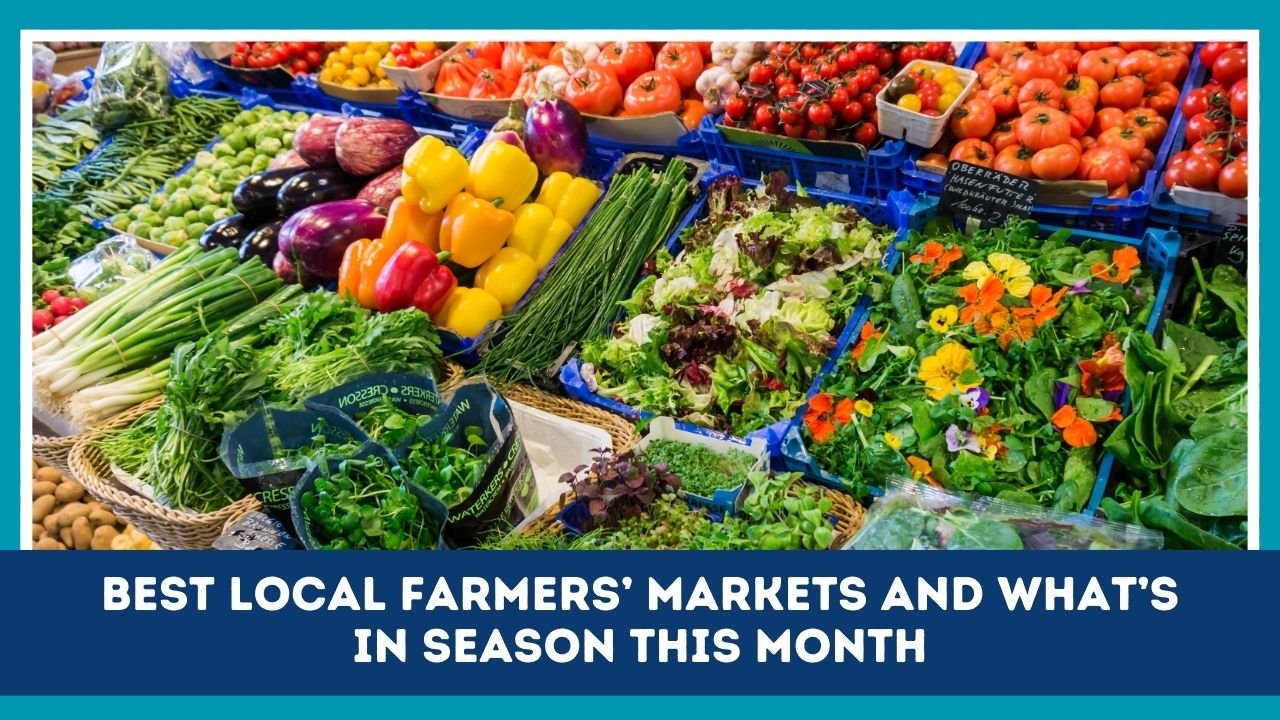If you love fresh, local, and seasonal food, September is your sweet spot.
It’s the month when late-summer stars overlap with early-fall favorites, so market stalls are overflowing with color, fragrance, and flavor.
Whether you shop a big city hub or a small neighborhood pop-up, farmers’ markets connect you directly to local growers, artisan producers, and sustainable food systems—often at prices that beat supermarket specialty aisles.
This guide breaks down what’s in season, how to find the best markets near you, smart ways to stretch your budget, and how to store your haul so nothing goes to waste.
What’s In Season This Month
September is a transition month. Expect the last surge of summer produce alongside the first wave of fall crops.
Availability varies by region and weather, but the following items are widely in season across much of the country:
Peak Fruits
- Apples (early varieties arrive first), pears, grapes, figs, melons, and late plums
- In warmer areas, you may still find berries in small quantities
Peak Vegetables
- Tomatoes, sweet corn, bell peppers, cucumbers, green beans, eggplant, zucchini
- Early fall staples begin rolling in: winter squash (acorn, delicata, butternut), pumpkins, sweet potatoes, broccoli, cauliflower, kale, and spinach
Herbs & Specialty Items
- Basil (last call in cooler zones), cilantro, parsley, thyme, rosemary
- Foragers and specialty growers may offer mushrooms, honey, cider, and preserves
Quick tip: Ask farmers what was picked this morning and which varieties are peaking next week. Pre-ordering for pickup can lock in your favorites.
Best Local Farmers’ Markets To Visit Now
While every region has its gems, certain market styles consistently deliver an excellent September experience:
- Flagship City Markets: Large, year-round hubs with dozens (sometimes hundreds) of producers. Great for variety—think apples and pears beside heirloom tomatoes, artisan breads, cheese, and flowers.
- Neighborhood & Community Markets: Smaller, hyper-local events that spotlight nearby farms and makers. Expect friendly vibes, short lines, and ultra-fresh greens, peppers, and herbs.
- University & Campus Markets: Often timed with the school calendar; ideal for budget-friendly produce and seasonal salad greens.
- Covered Or All-Weather Markets: Perfect if September brings rain or early chills. You’ll still find peak grapes, figs, and the first winter squash.
- Evening & Weekday Markets: Great for commuters. Late-day shopping can yield discounts on seconds (blemished but tasty) that are perfect for cooking or preserving.
Well-known examples many shoppers love include the Union Square Greenmarket in New York, Ferry Plaza in San Francisco, Santa Monica Downtown in Southern California, Dane County Farmers’ Market in Madison, Portland State University Market in Oregon, Eastern Market in Detroit, and Boulder County’s markets in Colorado.
If you’re traveling this month, look up the local market—there’s a good chance one is open within a short drive.
How To Find Markets Near You
- Search By City Or ZIP: A quick map search with “farmers’ market near me” plus your city/ZIP usually brings up official listings with hours, vendor rosters, and parking info.
- Check City & County Pages: Many municipalities publish seasonal calendars and highlight markets with SNAP/EBT acceptance and nutrition incentives.
- Follow On Social Media: Markets post what’s in peak each week, last-minute vendor changes, and weather updates.
- Ask Your Local Co-op Or CSA: Food co-ops and community-supported agriculture networks often maintain current regional lists.
Smart Shopping Tips For September
- Arrive Early For Best Selection: You’ll catch heirloom tomatoes, sweet corn, and first-of-the-season apples before they sell out.
- Shop What’s Truly Seasonal: Buying in season maximizes flavor and value. If a stand overflows with peppers or grapes, that’s your cue.
- Bring Cash And Reusable Bags: Many vendors accept cards and digital wallets, but cash keeps lines moving. Sturdy bags protect delicate figs and ripe tomatoes.
- Buy Seconds For Cooking: Slightly blemished produce is often discounted—perfect for sauces, soups, jams, and freezing.
- Talk To Farmers: Ask about variety names, organic or spray-free practices, and best storage. You’ll learn which items are picked at peak ripeness.
Stretching Your Budget With Incentives
Farmers’ markets increasingly support food access through payment options and incentives:
- SNAP/EBT: Many markets process SNAP/EBT at an information booth. You receive tokens or paper scrip to spend on eligible foods at any participating stall.
- Double-Up Or Match Programs: In many regions, shoppers paying with SNAP/EBT can get a dollar-for-dollar match on fruits and vegetables up to a local daily cap. Names vary—commonly Double Up Food Bucks, Market Match, or Health Bucks—but the idea is the same: more produce for your budget.
- WIC & Senior Benefits: Look for Farmers’ Market Nutrition Program vouchers that can be used directly with produce vendors.
- Community Promotions: Some markets offer bundle discounts close to closing time or special preservation days (bulk deals on tomatoes, corn, or peppers).
Pro tip: Ask the info booth about today’s match limit and accepted benefit cards. Incentive amounts vary by location and season.
Storage, Prep, And Waste-Less Strategies
- Tomatoes: Store at room temperature away from sunlight for the best flavor. Use very ripe ones in sauce or salsa the same day.
- Peppers & Cucumbers: Keep in the crisper drawer. If they soften, roast or pickle to extend life.
- Greens & Herbs: Wrap in a slightly damp towel and place in a breathable bag. Refresh tired herbs by trimming stems and standing them in a glass of water.
- Apples & Pears: Ripen pears on the counter, then refrigerate. Apples keep best chilled and away from fragrant foods.
- Winter Squash & Sweet Potatoes: Store in a cool, dry spot with air circulation—great pantry staples for soups and roasts.
- Batch Prep: Roast trays of peppers, eggplant, and squash for easy meals all week; freeze corn kernels and par-baked apple slices for quick desserts.
Seasonal Produce Snapshot — September
| Category | In-Season Standouts | How To Choose | How To Store | Budget Tip |
|---|---|---|---|---|
| Apples & Pears | Early apples, Bosc/Anjou pears | Firm fruit with a fresh aroma; avoid bruises | Refrigerate; ripen pears on counter first | Buy small mixed bags to sample varieties |
| Grapes & Figs | Table grapes, black/mission figs | Look for plump skins; figs should feel soft, not mushy | Chill grapes; eat figs within 1–2 days | Buy by the flat near closing for better pricing |
| Tomatoes | Heirloom, cherry, paste types | Heavy for size, fragrant; avoid chilled fruit | Counter storage; use ripe ones promptly | Get “sauce boxes” of seconds for bulk salsa/sauce |
| Peppers & Eggplant | Bells, sweet Italian, poblanos; globe/Asian eggplant | Glossy skins, firm flesh | Refrigerate; roast or grill if softening | Ask for multi-color bundles at a discount |
| Sweet Corn | Bi-color and yellow | Tight husks, sticky silk, full-feeling ears | Refrigerate and use quickly | Bulk-buy, then blanch & freeze kernels |
| Green Beans & Cucumbers | Haricot verts, slicers, picklers | Snappy pods; cucumbers firm with no soft spots | Refrigerate; use within a few days | Pickle larger, less-perfect cucumbers |
| Winter Squash & Pumpkins | Acorn, delicata, butternut, sugar pumpkins | Hard rinds, intact stems | Cool, dry storage; weeks to months | Choose varieties with edible skin (e.g., delicata) |
| Leafy Greens & Brassicas | Kale, chard, spinach, broccoli, cauliflower | Crisp leaves, compact heads | Refrigerate; don’t wash until use | Buy in bunches and prep for salads ahead |
| Herbs | Basil, parsley, cilantro, thyme | Vibrant color, no slime | Damp towel + bag, or stems in water | Get a “seconds” bunch for pesto and sauces |
Meal Planning With Market Finds
- Build Around One Star: Pick a centerpiece—say, heirloom tomatoes—and plan a week: caprese salad, roasted cherry tomatoes for pasta, and a fresh salsa night.
- Use A Two-Color Rule: Choose two colors per meal (e.g., green beans + red peppers) for balance and eye appeal.
- Cook Once, Eat Twice: Roast winter squash and turn leftovers into soup, salad, or tacos.
- Preserve While It’s Plentiful: Freeze grapes for snacks, dry herbs, can apple butter, and stash corn for chowders later.
Sustainability And Community Benefits
Shopping at farmers’ markets supports local economies, reduces food miles, and preserves regional crop diversity.
Your dollars help family farms stay viable, encourage regenerative and organic practices, and keep culinary traditions alive—like heritage apple and pear varieties or region-specific chiles.
Many markets also host nutrition education, chef demos, and food-recovery partners that donate unsold produce to community organizations.
Market Day Checklist
- Reusable Bags & Produce Sacks
- Small Bills (and a card/digital wallet as backup)
- Cooler Bag for figs, dairy, meats, or greens
- Meal Plan with 2–3 flexible recipes
- Questions for growers (varieties, storage, pesticide practices)
September at the farmers’ market is a feast for the senses and the pantry.
You’ll still catch the best of summer—tomatoes, sweet corn, peppers, melons—while welcoming the cozy goodness of fall—apples, pears, winter squash, sweet potatoes, and hardy greens.
With simple strategies—shopping in season, taking advantage of SNAP/EBT and local match programs, buying seconds for cooking, and storing produce correctly—you can fill your kitchen with peak-flavor ingredients without overspending.
Talk to farmers, try new varieties, and plan a little time for preserving.
Your meals will taste better, your budget will go further, and your community will be stronger for it.
FAQs
How Do I Find A Farmers’ Market Near Me?
Search “farmers’ market near me” with your city or ZIP, check local government or community pages, and follow markets on social media for weekly updates on vendors, hours, and what’s in season.
What Should I Prioritize Buying In September?
Focus on peak-season items for the best flavor and value: apples, pears, grapes, figs, tomatoes, peppers, green beans, sweet corn, winter squash, and sweet potatoes. Ask growers which varieties are at peak this week.
Can I Save Money With Incentive Programs?
Yes. Many markets take SNAP/EBT and offer dollar-for-dollar produce matches through programs like Double Up Food Bucks, Market Match, or Health Bucks. Visit the info booth to learn the daily match limit and how to redeem tokens.

